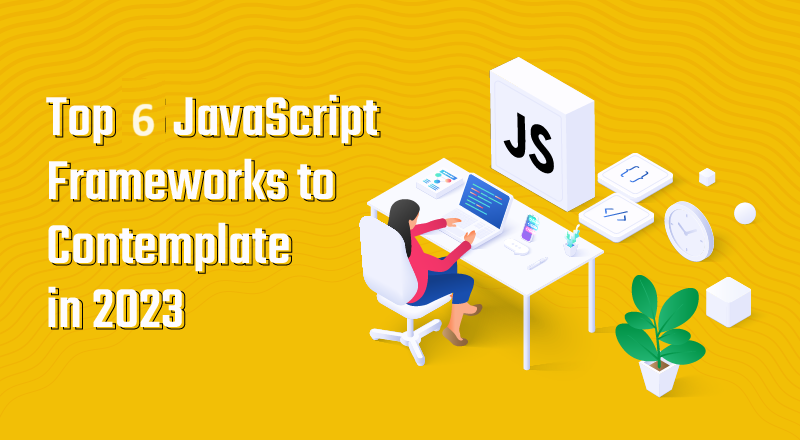The Best 6 JavaScript Frameworks for Developers
Java may be used for machine learning effectively, even though Python and R are more known for it, especially if you are already familiar with it.
JavaScript plays an important role for integrating machine learning (ML) into web applications, designing user interfaces, and delivering models on the client side, even though it may not be the first choice for developing and training machine learning models. In the machine learning ecosystem, it is a companion to Python and enables developers to create end-to-end solutions with both frontend and backend components.
Java can be used for machine learning, even if Python and R are more popular choices—especially if you’re already skilled with it. We’ve gathered a list of various significant Java frameworks for machine learning, data science, data visualisation, natural language processing, and other related fields in addition to Brains.js, Keras.js, and TensorFlow.js.
Let Explore some of the Js Frameworks
Synaptic.js
Machine learning model building and training are made possible using Synaptic.js, a well-known open-source neural network toolkit written in JavaScript. It supports first-order and second-order neural network designs and claims an architecture-neutral nature. This adaptable tool can be used for a variety of machine learning tasks, including network building and training, recurrent neural network (RNN) and long short-term memory (LSTM) capabilities, game development, predictive modelling, and more.
OpenCV.js
With the help of OpenCV.js, a JavaScript binding that extends OpenCV’s extensive collection of vision functions to web applications, web-based projects are given access to multimedia processing capacity. By converting OpenCV functions into asm.js or WebAssembly targets using Emscripten, OpenCV.js provides a JavaScript API for web projects to use these functionalities.
Its advantages include seamless browser integration, making it simple for internet users to access, supporting multimedia processing for new web applications, expanding the use of OpenCV by giving languages other than C and C++ a JavaScript interface, and delivering fast performance through ASM.js and SIMD.js. All of these features are provided for free under a BSD licence. It has uses in interactive art installations, feature extraction, object and face detection, camera calibration, machine learning, automated inspection, and surveillance.
D3.js
The JavaScript package known as D3.js, or Data-Driven Documents, enables programmers to create dynamic and interactive web data visualisations. With the ability to perform complex data activities like filtering, binding, and modification, it offers a broad variety of chart kinds, such as bar charts, line charts, scatterplots, and interactive maps. D3.js makes it easier to create highly responsive and personalised data visualisations by seamlessly fusing Scalable Vector Graphics (SVG) with HTML elements.
Additionally, it offers a variety of layout methods for creating complex visualisations including network graphs and hierarchical layouts. D3, which is primarily used in academic and journalistic endeavours, is a flexible tool for converting data into eye-catching visuals. It supports a variety of chart styles, including box plots, histograms, treemaps, chart graphs, scatter plots, line charts, bar charts, and pie charts. It offers a complete suite for data analysis and storytelling and further boosts visual appeal with animation features including animated treemaps, zoomable bar charts, icicles, and bar chart races.
Compromise.js
Compromise.js, a powerful toolkit for parsing, comprehending, and altering English text, is designed for natural language processing for both Node.js and browser environments. It is similar to NLP.js. Its plugin system, which makes it easier to install custom modules to expand functionality, is another advantage. Users of Compromise can easily extract a wide range of text components, including nouns, verbs, adjectives, dates, times, and addresses.
Additionally, it enables textual features like capitalization, contractions, and expansions. It also includes verb conjugation, part-of-speech tagging, sentiment analysis, and named entity recognition. Compromise, in particular, stands out for its efficiency, handling almost the whole English lexicon with just 14,000 words compressed into a small 40kb file size. This outstanding compression allows for quick text interpretation and scanning with a millisecond-low latency.
ConvNetJS
ConvNetJS is a JavaScript toolkit created by deep learning expert Andrej Karpathy that enables users to train deep learning models, in particular neural networks, right within their web browsers. Notably, ConvNetJS does not require specialised software like GPUs or compilers because it makes use of the hardware acceleration capabilities of the browser. In order to create and solve neural networks for a variety of tasks, such as classification, regression, image processing with convolutional networks, and experimental reinforcement learning with Deep Q Learning, it provides accessible JavaScript tools.
It also includes support for Node.js and is available as open source on GitHub under the MIT licence, where contributors are encouraged to suggest updates and new features. ConvNetJS is a powerful tool for quickly and easily training deep learning models in web browsers.
JSFeat
A JavaScript library for computer vision called JSFeat makes it possible for JavaScript to use a variety of image processing and computer vision methods. Edge detection, image processing (including blur and grayscale operations), corner detection, object identification, optical flow detection, and other operations are among its capabilities. The extensible matrix_t structure, which acts as a flexible foundation for activities ranging from image representation to mathematical calculations, is at the core of JSFeat.
The library also uses a cutting-edge linked pool-based cache mechanism to optimise buffer allocation and boost performance. JSFeat specifically offers portability across JavaScript-supported platforms, ease of integration with other programming languages, real-time performance for demanding applications, and comprehensive documentation for developer convenience in addition to the inherent advantages of JavaScript, such as speed, user-friendliness, versatility, and cross-platform compatibility.



